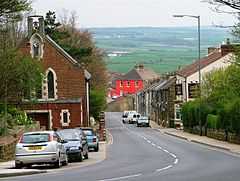Brotton
| Brotton | |
 Brotton High Street |
|
 Brotton | |
| OS grid reference | NZ685198 |
|---|---|
| - London | 210 mi (340 km) S |
| Civil parish | Skelton and Brotton |
| Unitary authority | Redcar and Cleveland |
| Ceremonial county | North Yorkshire |
| Region | North East |
| Country | England |
| Sovereign state | United Kingdom |
| Post town | SALTBURN-BY-THE-SEA |
| Postcode district | TS12 |
| Dialling code | 01287 |
| Police | Cleveland |
| Fire | Cleveland |
| Ambulance | North East |
| EU Parliament | North East England |
| UK Parliament | Middlesbrough South and East Cleveland |
Brotton is a village in the parish of Skelton and Brotton, in the unitary authority of Redcar and Cleveland and ceremonial county of North Yorkshire, England. It is situated approximately 2.5 miles (4 km) south-east of Saltburn-by-the-Sea, 12 miles (19 km) east of Middlesbrough and 14 miles (23 km) north-west of Whitby. In 2002, the village had a population of 5,384.[citation needed]
History
The name of the village (known in medieval times as 'Broctune') literally means, "town on the brow of a hill", and is listed in the Domesday Book. The hill in question, Warsett Hill, tops the large Huntcliffe which was the site of one of the many Roman signal stations built along the east coast to defend against Anglo-Saxon attack. Brotton was one of a number of manors granted by William the Conqueror to Robert de Brus, Lord of Skelton. Over recent years Brotton has become somewhat isolated because of a bypass which was opened in 1998 between the villages of Skelton-in-Cleveland and Carlin How.
The discovery of ironstone brought major changes to the village and a large increase in the population. The majority of former miners' homes are found in the 'Brickyard' and 'the Park' areas of the village. Lumpsey Mine, the largest of the Brotton mines, opened in the 1880s and closed in 1954. During the First World War Lumpsey Mine had a rail-mounted artillery piece to defend the mine against Zeppelin attack.
Community
Brotton is close to the historic seaside town of Saltburn-by-the-Sea, known for its pier, and Guisborough, with its ancient Priory and market.
The village is divided into two parts: 'Top End' (the area east of the railway line) and 'Bottom End' (the area to the west).
Brotton Anglican church is dedicated to St Margaret. The village contains a parade of shops on High Street, and its public houses include The Crown, The Ship, The Green Tree and The Queen's Arms.
Brotton has two primary schools, Badger Hill Primary School and St Peters Church of England school. There is also a school for children with learning difficulties, Kilton Thorpe. The village secondary school, Freebrough Academy, has recently been rebuilt.
The sculptor Charles Robinson Sykes (1875-1950), was born in the village. He designed the Spirit of Ecstasy mascot which is used on Rolls-Royce cars.[1]
References
- ↑ Triton, Paul (1986); "Eleanor, in body or spirit?", Rolls-Royce Owners' Club of Australia Library. Retrieved 15 January 2014
External links
 Media related to Brotton at Wikimedia Commons
Media related to Brotton at Wikimedia Commons- Skelton & Brotton Parish Council
- Redcar & Cleveland Borough Council
- "Welcome to Brotton History", This is the North East, Communigate.co.uk
| ||||||||||||||
| ||||||||||||||||||||